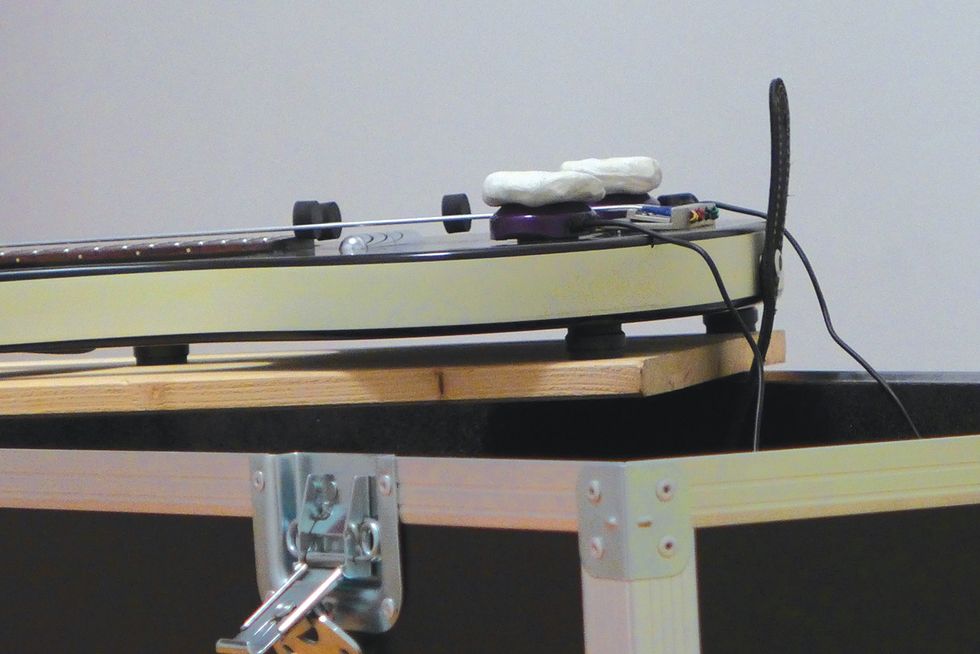As musicians, we all know the effects of music reach far beyond just fun and entertainment, whether it's helping with depression, influencing our basic mood, bringing people together, or one of myriad other reasons.
But then there are those surprising finds. Swiss cheesemaker Beat Wampfler partnered with a research team from the Bern University of the Arts in Switzerland to improve the taste of his Emmentaler cheese. There are a lot of factors, like humidity, temperature, and nutrients during gestation, involved in the cheese's final taste and aroma.
However, the primary objective of this project was to determine whether one could taste what those wheels of cheese had been listening to during their six months of gestation. The choice of music for each wheel of cheese ranged from The Magic Flute by Mozart to Led Zeppelin's “Stairway to Heaven" on a 24/7 loop. The team also incorporated some hip-hop by A Tribe Called Quest and EDM from Vril, among other varying genres. And, of course, there was also an untreated control group.
After the aging of the music-infused cheese, the team conducted a blindfolded taste test in a standardized experimental design, performed by several specially trained food-sensory researchers. The final outcome? The experts determined the hip-hop-laced cheese came out on top, with the strongest aroma and taste. Meanwhile, the arts team learned more about the scientific field of sonochemistry, which looks at the impact of sound on chemical reactions in solid bodies and plants.
The first experiments exposing plants to music started in 1962, and the many that followed found that classical music could enhance both the growth and yield of plants. In 2004, the rather anarchistic TV show MythBusters set up a similar experiment by exposing plants to several music styles, as well as positive and negative talk. The plants apparently didn't care whether you talked nicely to them or not, just as long as you did so. In the end, heavy metal music was the victor, with the most growth.
As entertaining as these “studies" are, I hope they don't lead anyone to seriously believe any cheese or plant has any sort of musical preferences. The topic, however, shows a few similarities to musicians who believe their instruments have to be “played in" for optimal tone, or that vintage instruments are superior simply because they've been played for so many decades.
With that belief, there is, of course, a market for devices to speed up the process of breaking in basses and guitars, mainly by attaching speakers to the instrument close to the bridge. It's interesting that when devotees of the process/technology argue its merits and how it all works, they often refer to the influence of sound on plants. First and foremost, there is a huge difference between a system of living cells and a guitar's wooden body. One consists of cells transporting all kinds of fluids and nourishments—it is well known that vibration can significantly stimulate division and cell-membrane fluidity—while the other one is a dead tree, plain and simple.
One company's process suggests using white and pink noise to specifically trim it to your preferred personal sound. Pink noise covers all audible frequencies with higher amplitudes in the bass register than the equally weighed white noise. So, if you want more bass from the instrument, simply extend the exposure time to pink noise, right? But they also say the process can be even more specific if you play the music genre to the instrument you plan to ultimately use it for, and to “make it loud, but never let the signal distort." Following this logic, wouldn't that mean bad news if you plan on playing death metal? And is my instrument ruined if my band members prank me by secretly playing Wham's “Last Christmas" to my bass on a loop?
The theory behind the process is that feeding external vibrations within the resonance range reduces internal tensions, and that the applied energy remains in the material and raises even more over time. This is partially true, as all the applied vibrational energy is heating up the body, but it also implies that you can store this energy to let it drain out via the output jack once you plug in.
To me, the whole played-in idea is simply a psychological effect, where every minute spent with your instrument deepens your relationship with it. It's similar to how hugging a tree feels like reconnecting to nature for some, while the tree couldn't care less. It's not that applying vibrations to wood can't have influences on its mechanical properties. But if so, it's way more likely to be a treatment to soften the tops of acoustic instruments, which might allow for stronger movements and a more dynamic reaction to the strings. With electric solidbody basses and guitars? Not so much. That said, if you can spend the cash, feeling better might be enough of a reason to give it a try!








![Rig Rundown: AFI [2025]](https://www.premierguitar.com/media-library/youtube.jpg?id=62064741&width=1245&height=700&quality=70&coordinates=0%2C0%2C0%2C0)












 Shop Scott's Rig
Shop Scott's Rig


![Rig Rundown: Russian Circles’ Mike Sullivan [2025]](https://www.premierguitar.com/media-library/youtube.jpg?id=62303631&width=1245&height=700&quality=70&coordinates=0%2C0%2C0%2C0)












































